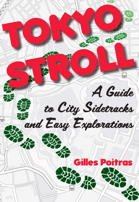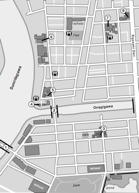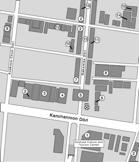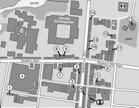











Tokyo Stroll Supplement: Bunkyō Ku

This page indexes, contains corrections, and has additions to Bunkyō Ku in Tokyo.
Related pages for specific neighborhoods/areas exist for Hakusan / Koishikawa, Hongō, and Yanesen (which is partly in Bunkyō Ku).
For information on Tokyo Stroll and this web supplement see Tokyo Stroll Supplement home page
For users of the Organic Maps, Maps.Me and Google Maps apps the items below have bookmarks you can import into those apps to make navigation easier.
Instructions and links are on the Viewing Locations in Organic Maps, Maps.Me, Google Maps, or Google Earth page.
Some entries on this page may include a note that says "Description to be added soon ." These entries are for items I felt should be listed even if the description is not ready to assist those who wish to plan a trip. When possible I included a link to an official web page, I suggest also doing web searchs for more information.
Bunkyō ku (文京区):
Formed in 1947 by the merger of the Hongo and Koishikawa wards as part of the post war reorganization of Tokyo.
Official pages for each of the ku of Tokyo will have sections of interest to visitors. These will likely be labeled as dealing with culture, tourism, or events.
Bunkyō-ku official site: https://www.city.bunkyo.lg.jp
Akamon / Red Gate (赤門): Tokyo Stroll, Hongō Chapter, page 168
NEAREST TRAIN/SUBWAY STATION: Hongō-sanchōme Station (Tokyo Metro Marunouchi Line, Toei Ōedo Line)
Amezaiku Yoshihara Sendagi (あめ細工吉原 千駄木): Tokyo Stroll, Yanesen Chapter, page 456
NEAREST TRAIN/SUBWAY STATION: Sendagi Station (Tokyo Metro Chiyoda Line)
WEB: https://ame-yoshihara.com
Baseball Hall of Fame and Museum / Yakyū Dendō Hakubutsukan (野球殿堂博物館)
Description to be added soon
NEAREST TRAIN/SUBWAY STATIONS: Kōrakuen Station (Tokyo Metro Marunouchi Line, Tokyo Metro Namboku Line), Kasuga Station (Toei Mita Line, Toei Ōedo Line), Iidabashi Station (JR East Chūō–Sōbu Line, Tokyo Metro Tōzai Line, Tokyo Metro Yūrakuchō Line, Tokyo Metro Namboku Line, Toei Ōedo Line), Suidobashi Station (JR East Chūō-Sōbu Line, Toei Mita Line)
WEB: https://baseball-museum.or.jp
Bunkyō Civic Center (文京シビックセンター)
As you have walked through this part of Tokyo you may have occasionally noticed a large tall building to the South East. This is the building that houses the government offices for Bunkyō Ward, sometimes you will see it referred to as the Bunkyō City Hall. Once you are at the building take the elevator up to the 25th floor (Open: 9:00 – 8:30) observation deck where you can enjoy an excellent 330-degree view of the city. If it is a clear day you will have a good view of Mount Fuji beyond the skyscrapers of Shinjuku. You may even spot a few things in the neighborhood to explore if the sun is still up.
NEAREST TRAIN/SUBWAY STATIONS: Kasuga Station (Toei Mita Line, Toei Ōedo Line), Kōrakuen Station (Tokyo Metro Marunouchi Line, Tokyo Metro Namboku Line
Bunkyō Historical Museum / Bunkyō Furusato Rekishikan (文京ふるさと歴史館): Tokyo Stroll, Hongō Chapter, page 180
NEAREST TRAIN/SUBWAY STATION: Kasuga Station (Toei Subway Mita Line, Toei Subway Ōedo Line)
WEB: https://www.city.bunkyo.lg.jp/rekishikan/
Chōjiya (丁子屋): Tokyo Stroll, Yanesen Chapter, page 458
NEAREST TRAIN/SUBWAY STATION: Nezu Station (Tokyo Metro Chiyoda Line)
Dangozaka (団子坂): Tokyo Stroll, Yanesen Chapter, page 456
NEAREST TRAIN/SUBWAY STATION: Sendagi Station (Tokyo Metro Chiyoda Line)
Denzūin (傳通院): Tokyo Stroll, Hakusan / Koishikawa Area Chapter, page 165
NEAREST TRAIN/SUBWAY STATION: Kasuga Station (Toei Mita Line, Toei Ōedo Line)
WEB: http://www.denzuin.or.jp
Eisei Bunko (永青文庫)
Description to be added soon
NEAREST TRAIN/SUBWAY STATIONS: Waseda Station (Toden Arakawa Line), Edogawabashi Station (Yūrakuchō Line)
WEB: https://www.eiseibunko.com
Enjōji (圓乘寺): Tokyo Stroll, Hakusan / Koishikawa Area Chapter, page 153
NEAREST TRAIN/SUBWAY STATION: Hakusan Station (Toei Mita Line)
Former Ise Pawnshop / Kyū Iseya Shichiten (旧伊勢屋質店): Tokyo Stroll, Hongō Chapter, page 183
NEAREST TRAIN/SUBWAY STATION: Kasuga Station (Toei Subway Mita Line, Toei Subway Ōedo Line)
Fujinomori Inari Shrine / Fujinomori Inari Jinja (藤之森稲荷神社): Tokyo Stroll, Hongō Chapter, page 182
NEAREST TRAIN/SUBWAY STATION: Hongō-sanchōme Station (Tokyo Metro Marunouchi Line, Toei Ōedo Line)
Genkakuji (源覚寺): Tokyo Stroll, Hakusan / Koishikawa Area Chapter, page 166
NEAREST TRAIN/SUBWAY STATION: Kasuga Station (Toei Mita Line, Toei Ōedo Line)
WEB: https://www.genkakuji.or.jp
Hakusan Shrine / Hakusan Jinja (白山神社): Tokyo Stroll, Hakusan / Koishikawa Area Chapter, page 153
NEAREST TRAIN/SUBWAY STATION: Hakusan Station (Toei Mita Line)
Hantei (はん亭)
A restaurant in an older three-story wooden building which has been designated an important cultural property. This is the original 1917 building having survived the major fires that destroyed so much of Tokyo. Hantei specializes in kushiage, deep-fried skewered meat and vegetables, elevated to fine cuisine. For easy ordering they serve one set course, the ichinozen which is six skewers served in sequence, further rounds can be ordered for a greatly reduced price until you are full. You can then finish off the meal with optional rice and desert. There are seasonal variants in what they serve which adds an element of traditional Japanese dining. There are some English speaking staff and an English menu. Seating is either traditional on tatami on the second and third floors or chairs at tables on the first.
NEAREST TRAIN/SUBWAY STATION: Nezu Station (Tokyo Metro Chiyoda Line)
WEB: http://hantei.co.jp
Harimazaka (播磨坂): Tokyo Stroll, Hakusan / Koishikawa Area Chapter, page 156
NEAREST TRAIN/SUBWAY STATION: Myōgadani Station (Tokyo Metro Marunouchi Line)
Higo-Hosokawa Garden / Higo Hosokawa Kōen (肥後細川庭園)
Description to be added soon
NEAREST TRAIN/SUBWAY STATIONS: Waseda Station (Toden Arakawa Line), Edogawabashi Station (Yūrakuchō Line)
WEB: https://www.higo-hosokawa.jp
Hikawa Shrine / Hikawa Jinja (簸川神社): Tokyo Stroll, Hakusan / Koishikawa Area Chapter, page 159
NEAREST TRAIN/SUBWAY STATIONS: Hakusan Station (Toei Mita Line), Myōgadani Station (Tokyo Metro Marunouchi Line)
Honmyōjizaka (本妙寺坂): Tokyo Stroll, Hongō Chapter, page 181
NEAREST TRAIN/SUBWAY STATION: Hongō-sanchōme Station (Tokyo Metro Marunouchi Line, Toei Ōedo Line)
Hōshinji (法真寺): Tokyo Stroll, Hongō Chapter, page 182
NEAREST TRAIN/SUBWAY STATION: Hongō-sanchōme Station (Tokyo Metro Marunouchi Line, Toei Ōedo Line)
WEB: http://www.hoshinji.jp/abouthoshinji/
Isego (伊勢五): Tokyo Stroll, Yanesen Chapter, page 458
NEAREST TRAIN/SUBWAY STATION: Sendagi Station (Tokyo Metro Chiyoda Line)
WEB:
https://isego.net/english/
Isetatsu (いせ辰): Tokyo Stroll, Yanesen Chapter, page 455
NEAREST TRAIN/SUBWAY STATION: Sendagi Station (Tokyo Metro Chiyoda Line)
WEB:
https://www.isetatsu.com
https://shinisetsuhan.net/collections/isetatsu
https://www.norenkai.net/en/portfolio-item/isetatsu/
Jigenin (慈限院): Tokyo Stroll, Hakusan / Koishikawa Area Chapter, page 164
NEAREST TRAIN/SUBWAY STATION: Kasuga Station (Toei Mita Line, Toei Ōedo Line)
Jirō Inari Shrine / Jirō Inari Jinja (次郎稲荷神社): Tokyo Stroll, Hakusan / Koishikawa Area Chapter, page 158
NEAREST TRAIN/SUBWAY STATIONS: Hakusan Station (Toei Mita Line), Myōgadani Station (Tokyo Metro Marunouchi Line)
Kaneyasu (かねやす): Tokyo Stroll, Hongō Chapter, page 180
NEAREST TRAIN/SUBWAY STATION: Hongō-sanchōme Station (Tokyo Metro Marunouchi Line, Toei Ōedo Line)
Kikumi Senbei (菊見煎餅): Tokyo Stroll, Yanesen Chapter, page 456
NEAREST TRAIN/SUBWAY STATION: Sendagi Station (Tokyo Metro Chiyoda Line)
Kikuzaka (菊坂): Tokyo Stroll, Hongō Chapter, page 183
NEAREST TRAIN/SUBWAY STATION: Kasuga Station (Toei Subway Mita Line, Toei Subway Ōedo Line)
Koishikawa Annex, Museum of Architecture, The University Museum, The University of Tokyo / Tōkyō-daigaku Sōgō Kenkyū Hakubutsukan Koishikawa bun’in (東京大学総合研究博物館 小石川分館): Tokyo Stroll, Hakusan / Koishikawa Area Chapter, page 158
NEAREST TRAIN/SUBWAY STATIONS: Hakusan Station (Toei Mita Line), Myōgadani Station (Tokyo Metro Marunouchi Line)
WEB: https://www.um.u-tokyo.ac.jp/architectonica/index_en.html
Koishikawa Botanical Garden / Koishikawa Shokubutsuen (小石川植物園): Tokyo Stroll, Hakusan / Koishikawa Area Chapter, page 156
NEAREST TRAIN/SUBWAY STATIONS: Hakusan Station (Toei Mita Line), Myōgadani Station (Tokyo Metro Marunouchi Line)
WEB: https://koishikawa-bg.jp
Koishikawa Kōrakuen (小石川後楽園)
A garden which was laid out in 1629 on the Mito Han estate by Tokugawa Yorifusa, his son Tokugawa Mitsukuni would oversee the completion of the work. An advisor on the construction of the garden was Zhu Zhiyu a noted Confucian scholar and refugee from China after the fall of the Ming Dynasty. It was he who gave the garden its name. Today this is the oldest garden in Tokyo Some noted features of the garden include the ponds, streams, manmade hills, older structures, bridges of stone or wood, many pathways, flowers, and a rice paddy for teaching how hard farmers worked which is still planted and harvested by school children today. Specifics on much of this can be found in the brochure given out at the garden. The garden is also known for Autumn foliage starting in late November, plum blossoms in February, cherry blossoms in late March, azaleas in April-May, and more than one type of iris in mid-April-June.
NEAREST TRAIN/SUBWAY STATION: Kōrakuen Station (Tokyo Metro Marunouchi Line, Tokyo Metro Namboku Line)
WEB: https://www.tokyo-park.or.jp/park/koishikawakorakuen/
Komagome Inari Shrine / Komagome Inari Jinja (駒込稲荷神社): Tokyo Stroll, Yanesen Chapter, page 461
NEAREST TRAIN/SUBWAY STATION: Nezu Station (Tokyo Metro Chiyoda Line)
Kōrakuen Hall / Kōrakuen hōru (後楽園ホール)
Description to be added soon
NEAREST TRAIN/SUBWAY STATIONS: Kōrakuen Station (Marunouchi Line, Namboku Line), Kasuga Station (Mita Line, Ōedo Line), Iidabashi Station (Chūō–Sōbu Line, Tōzai Line, Yūrakuchō Line, Namboku Line, Ōedo Line), Suidobashi Station (Chūō-Sōbu Line, Toei Mita Line)
Kyū Iwasaki-tei Garden / Kyū Iwasaki-tei teien (旧岩崎邸庭園): Tokyo Stroll, Hongō Chapter, page 175
NEAREST TRAIN/SUBWAY STATION: Yushima Station (Tokyo Metro Chiyoda Line)
WEB:
https://www.culture.city.taito.lg.jp/bunkatanbou/history/iwasaki_tei/iwasaki.html
http://teien.tokyo-park.or.jp/en/kyu-iwasaki/index.html
http://www.kensetsu.metro.tokyo.jp/content/000007565.pdf
http://www.kensetsu.metro.tokyo.jp/content/000026924.pdf
Mansei (萬盛): Tokyo Stroll, Hakusan / Koishikawa Area Chapter, page 164
NEAREST TRAIN/SUBWAY STATION: Kasuga Station (Toei Mita Line, Toei Ōedo Line)
Mori Ōgai Memorial Museum / Bunkyō Kuritsu Mori Ōgai Kinenkan (文京区立森鷗外記念館): Tokyo Stroll, Yanesen Chapter, page 457
NEAREST TRAIN/SUBWAY STATION: Sendagi Station (Tokyo Metro Chiyoda Line)
WEB: https://moriogai-kinenkan.jp
Nensokuji (念速寺): Tokyo Stroll, Hakusan / Koishikawa Area Chapter, page 159
NEAREST TRAIN/SUBWAY STATION: Kasuga Station (Toei Mita Line, Toei Ōedo Line)
WEB: https://welcometonensokuji.localinfo.jp
Nezu Shrine / Nezu Jinja (根津神社): Tokyo Stroll, Yanesen Chapter, page 458
NEAREST TRAIN/SUBWAY STATION: Nezu Station (Tokyo Metro Chiyoda Line)
WEB: https://nedujinja.or.jp
Obake Kaidan (おばけ階段)
Description to be added soon
NEAREST TRAIN/SUBWAY STATIONS: Nezu Station (Chiyoda Line), Todaimae Station (Namboku Line)
Printing Museum / Insatsu Hakubutsukan (印刷博物館)
Description to be added soon
NEAREST TRAIN/SUBWAY STATIONS: Edogawabashi Station (Yūrakuchō Line), Myogadani Station (Marunouchi Line), Iidabashi Station (Chūō-Sōbu Line, Tōzai Line, Yūrakuchō Line, Namboku Line, Ōedo Line)
WEB: https://www.printing-museum.org
Red Gate / Akamon (赤門): Tokyo Stroll, Hongō Chapter, page 168
NEAREST TRAIN/SUBWAY STATION: Hongō-sanchōme Station (Tokyo Metro Marunouchi Line, Toei Ōedo Line)
Reiunji (霊雲寺): Tokyo Stroll, Hongō Chapter, page 173
NEAREST TRAIN/SUBWAY STATIONS: Hongō-sanchōme Station (Tokyo Metro Marunouchi Line, Toei Ōedo Line), Yushima Station (Tokyo Metro Chiyoda Line)
Rikugien Gardens / Rikugien (六義園)
Description to be added soon
NEAREST TRAIN/SUBWAY STATIONS: Sengoku Station (Mita Line), Sugamo Station (Yamanote Line, Mita Line), Komagome Station (Yamanote Line, Namboku Line)
WEB: https://www.tokyo-park.or.jp/teien/en/rikugien/outline.html
Rinsenji (林泉寺)
This temple has an unusual type of Jizō statue, a shibarare Jizō, a "bound Jizō" which dates from 1602. This refers to a practice that started in the Edo Period of tying a string around a statue of Jizō as part of a prayer, when the prayer is answered the string is to be removed. Originally at this temple it was for the recovery of stolen or lost property, now people do for pretty much anything.
NOTE: The shibarare Jizō of Rinsenji is mentioned by Kodō Nomura in one of his Zenigata Heiji stories.
NEAREST TRAIN/SUBWAY STATION: Myōgadani Station (Tokyo Metro Marunouchi Line)
WEB: https://rinsenji.or.jp
Rinshōin (麟祥院): Tokyo Stroll, Hongō Chapter, page 175
NEAREST TRAIN/SUBWAY STATION: Hongō-sanchōme Station (Tokyo Metro Marunouchi Line, Toei Ōedo Line)
WEB: https://www.rinshouin.jp
St. Mary's Cathedral / Tōkyō Katedoraru Sei Maria Daiseidō (東京カテドラル聖マリア大聖堂)
Description to be added soon
NEAREST TRAIN/SUBWAY STATION: Waseda Station (Toden Arakawa Line)
WEB: https://catholic-sekiguchi.jp
Sakai Inari Shrine / Sakai Inari Jinja (境稲荷神社): Tokyo Stroll, Hongō Chapter, page 172
NEAREST TRAIN/SUBWAY STATION: Hongō-sanchōme Station (Tokyo Metro Marunouchi Line, Toei Ōedo Line), Nezu Station (Tokyo Metro Chiyoda Line)
Sansakizaka (三崎坂): Tokyo Stroll, Yanesen Chapter, page 456
NEAREST TRAIN/SUBWAY STATION: Sendagi Station (Tokyo Metro Chiyoda Line)
Sanshirō Pond / Sanshirō ike (三四郎池): Tokyo Stroll, Hongō Chapter, page 172
NEAREST TRAIN/SUBWAY STATION: Hongō-sanchōme Station (Tokyo Metro Marunouchi Line, Toei Ōedo Line)
Shinjuin (真珠院): Tokyo Stroll, Hakusan / Koishikawa Area Chapter, page 166
NEAREST TRAIN/SUBWAY STATIONS: Kasuga Station (Toei Mita Line, Toei Ōedo Line), Myōgadani Station (Tokyo Metro Marunouchi Line)
Snake Road / Hebimichi (へび道): Tokyo Stroll, Yanesen Chapter, page 458
NEAREST TRAIN/SUBWAY STATION: Sendagi Station (Tokyo Metro Chiyoda Line)
Sōkeiji (宗慶寺): Tokyo Stroll, Hakusan / Koishikawa Area Chapter, page 156
NEAREST TRAIN/SUBWAY STATION: Myōgadani Station (Tokyo Metro Marunouchi Line)
Sudō Park / Sudō Kōen (須藤公園): Tokyo Stroll, Yanesen Chapter, page 458
NEAREST TRAIN/SUBWAY STATION: Sendagi Station (Tokyo Metro Chiyoda Line)
Tadonzaka (炭団坂): Tokyo Stroll, Hongō Chapter, page 181
NEAREST TRAIN/SUBWAY STATION: Kasuga Station (Toei Subway Mita Line, Toei Subway Ōedo Line)
Takehisa Yumeji Museum / Takehisa Yumeji Bijutsukan (竹久夢二美術館): Tokyo Stroll, Hongō Chapter, page 173
NEAREST TRAIN/SUBWAY STATION: Nezu Station (Tokyo Metro Chiyoda Line)
WEB: https://www.yayoi-yumeji-museum.jp
Takuzōsu Inari Shrine / Takuzōsu Inari Jinja (澤蔵司稲荷): Tokyo Stroll, Hakusan / Koishikawa Area Chapter, page 164
NEAREST TRAIN/SUBWAY STATION: Kasuga Station (Toei Mita Line, Toei Ōedo Line)
WEB: https://takuzousuinari.com
Tarō Inari Shrine / Tarō Inari Jinja (太郎稲荷神社): Tokyo Stroll, Hakusan / Koishikawa Area Chapter, page 156
NEAREST TRAIN/SUBWAY STATIONS: Hakusan Station (Toei Mita Line), Myōgadani Station (Tokyo Metro Marunouchi Line)
Tayori
Description to be added soon
NEAREST TRAIN/SUBWAY STATION: Nippori Station (Keisei Main Line, Jōban Line, Keihin-Tōhoku Line, Yamanote Line), Sendagi Station (Chiyoda Line)
WEB: https://hagiso.com/tayori/
Tokyo Dome City (東京ドームシティ)
A large modern entertainment complex founded in 1955 which has been added to and changed many time since. Included are the Tokyo Dome baseball stadium, the Japanese Baseball Hall of Fame, a hotel, an amusement park, a bowling alley, a hotel, roller skating arena, a large theater, the hot spring La Qua, various other attractions, and the location of ever changing special events. This modern entertainment district provides quite the contrast to the many older sights found in Bunkyō Ward.
NEAREST TRAIN/SUBWAY STATIONS: Kōrakuen Station (Tokyo Metro Marunouchi Line, Tokyo Metro Namboku Line), Kasuga Station (Toei Mita Line, Toei Ōedo Line), Iidabashi Station (JR East Chūō–Sōbu Line, Tokyo Metro Tōzai Line, Tokyo Metro Yūrakuchō Line, Tokyo Metro Namboku Line, Toei Ōedo Line), Suidobashi Station (JR East Chūō-Sōbu Line, Toei Mita Line)
WEB: https://www.tokyo-dome.co.jp
Tokyo Waterworks Historical Museum / Tokyo To Suidō Rekishikan (東京都水道歴史館): Tokyo Stroll, Hongō Chapter, page 183
NEAREST TRAIN/SUBWAY STATIONS: Hongō-sanchōme Station (Tokyo Metro Marunouchi Line, Toei Ōedo Line), Ochanomizu Station (JR East Chūō Main Line, JR East Chūō Line, JR East Chūō-Sōbu Line, JR East Sōbu Main Line, Tokyo Metro Marunouchi Line)
WEB: https://www.suidorekishi.jp
Toyo Bunko Museum (東洋文庫ミュージアム)
Description to be added soon
NEAREST TRAIN/SUBWAY STATIONS: Sengoku Station (Mita Line), Komagome Station (Yamanote Line, Namboku Line)
WEB: https://toyo-bunko.or.jp/museum/
Tsuboya (壺屋): Tokyo Stroll, Hongō Chapter, page 174
NEAREST TRAIN/SUBWAY STATION: Hongō-sanchōme Station (Tokyo Metro Marunouchi Line, Toei Ōedo Line)
University Museum, The University of Tokyo / Tōkyō Daigaku Sōgō Kenkyū Hakubutsukan (東京大学総合研究博物館): Tokyo Stroll, Hongō Chapter, page 175
NEAREST TRAIN/SUBWAY STATION: Hongō-sanchōme Station (Tokyo Metro Marunouchi Line, Toei Ōedo Line)
WEB: https://www.um.u-tokyo.ac.jp/en/home-en
University of Tokyo / Tōkyō Daigaku (東京大学): Tokyo Stroll, Hongō Chapter, page 168
NEAREST TRAIN/SUBWAY STATION: Hongō-sanchōme Station (Tokyo Metro Marunouchi Line, Toei Ōedo Line)
WEB: https://www.u-tokyo.ac.jp/en/
Ushi-Tenjin Kitano Shrine / Ushi Tenjin Kitano Jinja (牛天神北野神社)
Founded in 1184 by Minamoto no Yoritomo, the first Kamakura shogun. Yoritomo had a dream in which Sugawara no Michizane standing on a cow shaped stone informed him two important events would take place. The shrine was then constructed as thanks.
The main entrance to the shrine grounds is to the East where there is a long stairway to the shrine. The shrine itself is an older wooden structure with some impressive komainu statues. The grounds are known for a ume blossom flower viewing festival early in the year. On the grounds you will see a sacred stone in straw rope enclosure, and a tall memorial stone to Nakajima Utako famous poet and instructor to many writers including Ichiyō Higuchi and Miyake Kaho. The memorial to Utako was put up after her death in 1903.
Enter on the West through a long pedestrian street and stairway.
NEAREST TRAIN/SUBWAY STATIONS: Kasuga Station (Toei Subway Mita Line, Toei Subway Ōedo Line),
Kōrakuen Station (Tokyo Metro Marunouchi Line, Tokyo Metro Namboku Line)
WEB: http://ushitenjin.jp
Wadatsumi no Koe Museum / Wadatsumi no Koe Kinenkan (わだつみのこえ記念館): Tokyo Stroll, Hongō Chapter, page 183
NEAREST TRAIN/SUBWAY STATION: Hongō-sanchōme Station (Tokyo Metro Marunouchi Line, Toei Ōedo Line)
WEB: http://www.wadatsuminokoe.org
Listen to the Voices from the Sea: https://www.press.uchicago.edu/ucp/books/book/distributed/L/bo3757809.html
Yayoi Museum / Yayoi Bijutsukan (弥生美術館): Tokyo Stroll, Hongō Chapter, page 173
NEAREST TRAIN/SUBWAY STATION: Nezu Station (Tokyo Metro Chiyoda Line)
WEB: https://www.yayoi-yumeji-museum.jp
Yayoiken Hongo (やよい軒 本郷)
The local branch of the restaurant chain Yayoi. I include it here as this is an excellent place to get a Japanese style breakfast at very reasonable prices. As you enter there is a machine where you can order and pay for your meal. This is a touch screen device and has an English menu option for easy selection. Pay for your meal, collect your ticket and change then seat yourself. You don't need to be able to speak Japanese as the ticket has your selection. Refills on rice and tea are free, just help yourself.
NEAREST TRAIN/SUBWAY STATION: Hongō-sanchōme Station (Tokyo Metro Marunouchi Line, Toei Ōedo Line)
WEB: https://www.yayoiken.com/en/
Yokoyama Taikan Memorial Hall / Yokoyama Taikan Kinenkan (横山大観記念館): Tokyo Stroll, Hongō Chapter, page 172
NEAREST TRAIN/SUBWAY STATION: Hongō-sanchōme Station (Tokyo Metro Marunouchi Line, Toei Ōedo Line), Nezu Station (Tokyo Metro Chiyoda Line)
WEB: https://taikan.tokyo
Yushima Seidō (湯島聖堂): Tokyo Stroll, Akihabara and Kanda Chapter, page 69
NEAREST TRAIN/SUBWAY STATION: Ochanomizu Station (JR East Chūō Line, JR East Chūō Main Line, JR East Chūō-Sōbu Line, JR East Sōbu Main Line, Tokyo Metro Marunouchi Line)
WEB: http://www.seido.or.jp
Yushima Shrine / Yushima Tenmangū (湯島天満宮): Tokyo Stroll, Hongō Chapter, page 173
NEAREST TRAIN/SUBWAY STATION: Yushima Station (Tokyo Metro Chiyoda Line)
WEB: https://www.yushimatenjin.or.jp/pc/index.htm
Zenkōjizaka Mukunoki Tree / Zenkōjizaka no Mukunoki (善光寺坂のムクノキ): Tokyo Stroll, Hakusan / Koishikawa Area Chapter, page 164
NEAREST TRAIN/SUBWAY STATION: Kasuga Station (Toei Mita Line, Toei Ōedo Line)
Back to the Tokyo Stroll Supplement home page - Privacy Notice - Back to Gilles' home page
Created September 23, 2024 | Content last updated October 11, 2025